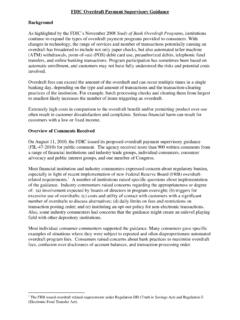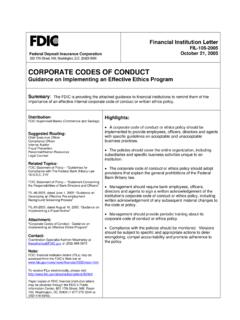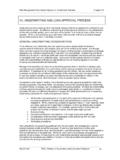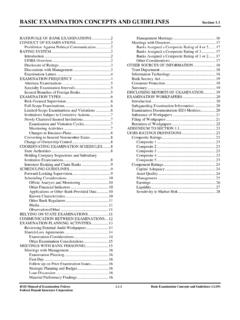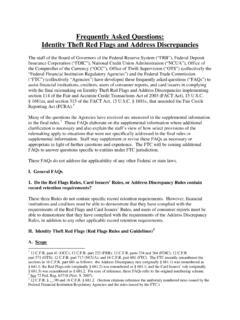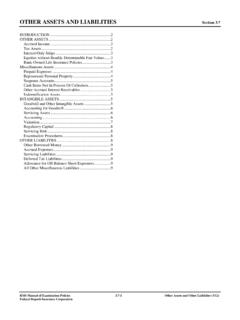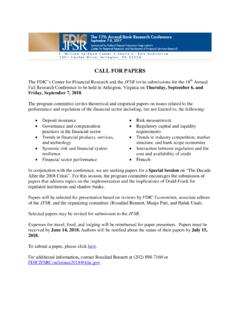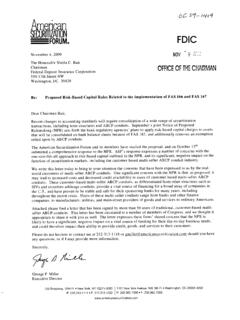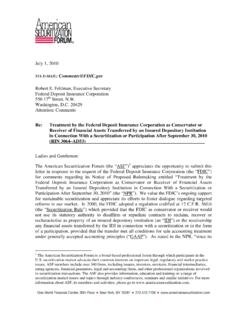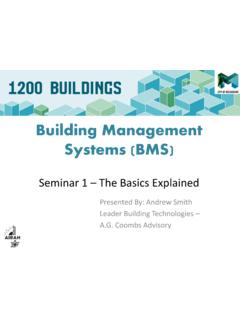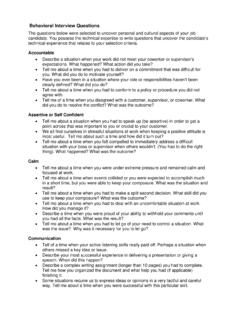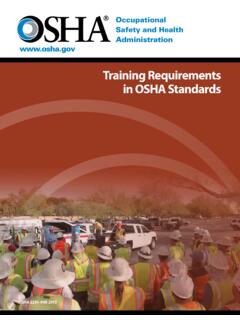Transcription of Managing Risks in Third-Party Payment Processor Relationships
1 3 supervisory Insights Summer 2011 Managing Risks in Third-Party Payment Processor RelationshipsDuring the past few years, the Federal Deposit Insur-ance Corporation (FDIC) has observed an increase in the number of deposit Relationships between financial institutions and Third-Party Payment processors and a correspond-ing increase in the Risks associated with these Relationships . Deposit rela-tionships with Payment processors can expose financial institutions to Risks not present in typical commer-cial customer Relationships , including greater strategic, credit, compliance, transaction, legal, and reputation risk.
2 It was for this reason in 2008 that the FDIC issued Guidance on Payment Processor Relationships which outlines risk mitigation principles for this type of higher-risk many Payment processors effect legitimate Payment transactions for a variety of reputable merchants, an increasing number of processors have been initiating payments for abusive telemarketers, deceptive online merchants, and organizations that engage in high risk or illegal activities. In the absence of adequate monitoring systems and controls, a financial insti-tution could be facilitating unauthor-ized transactions or unfair or deceptive practices resulting in financial harm to the consumer.
3 Therefore, it is essential that financial institutions and examin-ers recognize and understand the Risks associated with these article explains the role of Third-Party Payment processors and the Risks they can present to financial institu-tions, identifies warning signs that may indicate heightened risk in a Payment Processor relationship, and discusses the risk mitigation controls that should be in place to manage this risk. The article concludes with an overview of supervisory remedies that may be used when it is determined that a financial institution does not have an adequate program in place for monitor-ing and addressing the Risks associated with Third-Party Payment Processor core elements of Managing Third-Party risk are present in Payment Processor Relationships ( , risk assessment, policies and procedures, due diligence, and oversight).
4 Managing these Risks can be particularly chal-lenging as the financial institution does not have a direct customer relationship with the Payment Processor s merchant clients. Furthermore, the Risks asso-ciated with this type of activity are heightened when neither the Payment Processor nor the financial institution performs adequate due diligence, such as verifying the identities and business practices of the merchants for which payments are originated and imple-menting a program of ongoing monitor-ing for suspicious example, in a typical Third-Party Payment Processor relationship, the Payment Processor is a deposit customer of the financial institution which uses its deposit account to process payments for its merchant clients.
5 The Payment Processor receives lists of payments to be gener-ated by the merchant clients for the Payment of goods or services and initi-ates the payments by creating and depositing them into a transaction account at a financial institution. In some cases, the Payment Processor may establish individual accounts at the financial institution in the name 1 Financial Institution Letter (FIL) 127-2008, Guidance on Payment Processor Relationships , dated November 7, 2008. See: Insights Summer 2011of each merchant client and deposit the appropriate payments into these accounts. The merchant may then be a co-owner of the deposit account and make withdrawals from the account to receive its sales proceeds, or the Payment Processor may periodically forward the sales proceeds from the account to the merchant.
6 Alterna-tively, the Payment Processor may commingle payments originated by the merchant clients into a single deposit account in the name of the Payment Processor . In this case, the Payment Processor should maintain records to allocate the deposit account balance among the merchant Types Used by Third-Party Payment ProcessorsPayment processors may offer merchants a variety of alternatives for accepting payments including credit and debit card transactions, traditional check acceptance, Auto-mated Clearing House (ACH) debits and other alternative Payment chan-nels. The potential for misuse or fraud exists in all Payment channels.
7 However, the FDIC has observed that some of the most problematic activ-ity occurs in the origination of ACH debits or the creation and deposit of remotely created checks. Automated Clearing House DebitsThe ACH network is a nationwide electronic Payment network which enables participating financial institu-tions to distribute electronic credit and debit entries to bank accounts and settle these entries. Common ACH credit transfers include the direct deposit of payroll and certain benefits payments. Direct debit transfers also may be made through the ACH network and include consumer payments for insurance premiums, mortgage loans, and other types of bills.
8 Rules and regulations governing the ACH networks are established by NACHA - The Elec-tronic Payments Association (formerly National Automated Clearing House Association)2 and the Board of Gover-nors of the Federal Reserve Payment proces-sors initiate ACH debit transfers as payments for merchant clients by submitting these transfers, which contain the consumer s financial insti-tution routing number and account number (found at the bottom of a check) to their financial institution to enter into the ACH networks. Telemarketers and online merchants obtain this information from the consumer and transmit it to the Payment Processor to initiate the ACH debit transfers.
9 The risk of fraud arises when an illicit telemarketer or online merchant obtains the consum-er s account information through coercion or deception and initiates an ACH debit transfer that may not be fully understood or authorized by the with all Payment systems and mechanisms, the financial institution bears the responsibility of implement-ing an effective system of internal controls and ongoing account monitor-ing for the detection and resolution of fraudulent ACH transfers. If an unauthorized ACH debit is posted to a consumer s account, the procedures for resolving errors contained in the Federal Reserve Board s Regulation E, Third-Party Payment Processorscontinued from pg.
10 32 NACHA establishes the rules and procedures governing the exchange of automated clearinghouse payments. See Insights Summer 2011which governs electronic funds trans-fers,3 provide the consumer 60 days after the financial institution sends an account statement to report the unauthorized ACH Regulation E requires the consumer s financial institution to investigate the matter and report to the consumer the results of the investigation within a prescribed time frame. In the case of an ACH debit, when a consumer receives a refund for an unauthorized debit, ACH rules permit the consumer s financial institution to recover the amount of the unauthorized Payment by return-ing the debit item to the originating financial Created ChecksRemotely Created Checks (RCCs), often referred to as demand drafts, are Payment instruments that do not bear the signature of a person on whose account the payments are drawn.
